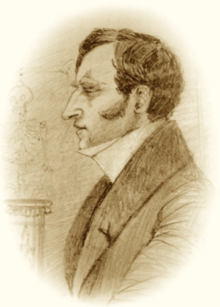| Henry Riley | |
|---|---|
 Undated portrait of Henry Riley Undated portrait of Henry Riley | |
| Born | 1797 Bristol |
| Died | 1848 (age 50-51) Bristol |
| Nationality | English |
| Known for | Discovery of Palaeosaurus and Thecodontosaurus |
| Scientific career | |
| Fields | Geology, Natural history, Anatomy |
Henry Riley (1797–1848) was a British surgeon, anatomist, naturalist, geologist and paleontologist. He is notable for being the co-discoverer and co-describer of the archosaur Palaeosaurus and the dinosaur Thecodontosaurus.
Biography
Henry Riley was born in Bristol in 1797. He trained to become a surgeon in Paris and he graduated during the mid-1820s. He was one of the men who founded the Bristol Institution in the 1820s. Riley was involved in a body snatching scandal in the late 1820s - he was fined £6 (inflated to £657.29 in 2019) in 1828. He was later revoked of this claim during the 1830s.
His Geoffroyan lectures of 1831-33 were the first to be heard in Bristol. He was a physician at St. Peter's Hospital, Bristol in 1832 and the Bristol Royal Infirmary between 1834 and 1847. He taught at Bristol Medical School until he retired in 1846.
In 1833, Riley described the extinct ray-like chimaeriform Squaloraja based on a specimen found by Mary Anning. In the autumn of 1834, Riley and the curator of the Bristol Institution, Samuel Stutchbury, began to excavate "saurian remains" at the quarry of Durdham Down, at Clifton, presently a part of Bristol, which is part of the Magnesian Conglomerate. In 1834 and 1835, they briefly reported on the finds. They provided their initial description in 1836, naming the new genera Palaeosaurus and Thecodontosaurus.
Riley died in 1848 in Bristol, aged 50 or 51.
References
- ^ Adrian Desmond (15 April 1992). The Politics of Evolution: Morphology, Medicine, and Reform in Radical London. Chicago: University of Chicago Press. p. 427. ISBN 978-0-226-14374-3.
- "Palaeobiology and Biodiversity Research Group, Department of Earth Sciences, University of Bristol". bristol-dinosaur.gly.bris.ac.uk. Bristol: University of Bristol. Retrieved 22 August 2020.
- "Bristol City Council : Museum Collections". museums.bristol.gov.uk. Bristol: Bristol City Council. Retrieved 22 August 2020.
- ^ The Geological Curator, 10 (8). pp. 493-498.
- Taylor, Michael A, Torrens, H. S. (2017) - 280. Henry Riley M.D. (1797-1848) of Bristol.
- Itano, Wayne M.; Duffin, Christopher J. (2023). "An enigmatic chondrichthyan spine from the Visean of Indiana, USA that resembles a median rostral cartilage of Squaloraja (Holocephali, Chimaeriformes)". Spanish Journal of Paleontology. 38 (1).
- Williams, 1835, "Discovery of Saurian Bones in the Magnesian Conglomerate near Bristol", American Journal of Science and Arts 28: 389
- "Dinosaur find marked at cemetery". BBC News. Britain. 17 February 2011. Retrieved 22 August 2020.